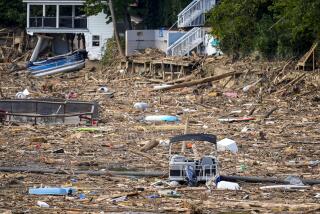Floyd’s Effects Devastate North Carolina
- Share via
PRINCEVILLE, N.C. — Emergency workers in boats and Marines in helicopters swarmed into North Carolina’s coastal plain on Friday to rescue more than 1,000 people from roofs and trees after the torrential rains of Hurricane Floyd. Another 800 people were saved in New Jersey.
After rampaging up the entire East Coast, Floyd left at least 29 people dead, thousands of homes and businesses damaged and more than a million people without electricity or water.
Although the storm was nowhere near the monster that was feared, it dumped enough rain to create one of North Carolina’s worst natural disasters ever and cause unprecedented flooding in New Jersey.
In Bound Brook, N.J., serious flooding from the Raritan River forced police to rescue at least 800 people, many of them from second-floor windows or off porch roofs.
“We’ve never seen anything like this,” New Jersey Gov. Christine Todd Whitman said. “This is going to take a long time. This is not something that is going to be cleaned up immediately.”
President Clinton declared an emergency in the state, allocating federal funding to help deal with the cleanup.
In southeastern Pennsylvania, more than 4,000 people were homeless Friday after torrential rains sent rivers over their banks.
In North Carolina, James Lee Witt, director of the Federal Emergency Management Agency, said the damage appeared worse than the state’s worst-ever natural disaster, Hurricane Fran, which inflicted $6 billion worth of damage in 1996.
The storm dumped 15 inches of rain on North Carolina’s coastal plain--two weeks after an 8-inch rainfall from Hurricane Dennis--and the effects were devastating.
In Princeville, under 12 feet of water, rescue choppers roared over the town of 1,600. The nearby Tar River, already 13 feet above flood stage, was expected to rise another 2 feet.
Rescuers helped Curtis and Doris Whitehead and Curtis’ mother, Bessie Whitehead, into a boat from their home outside Princeville.
“I’m so scared. I’ve never been in a boat before. I just want to get out,” Bessie Whitehead said.
Neighbors Shaveda Shaw and her sister cradled their teenage brother, who has cerebral palsy, in a boat as it glided away from their home across a flooded ditch.
“I’ve been here 20 years, and I’ve never seen it like this,” Shaw said.
In Rocky Mount, 30 miles upriver, Miriam Tharrington gazed at the house she grew up in, now under 6 feet of water. “Never, never has it been like this,” she said. “This is not in a flood plain. We don’t have flood insurance.”
Many people were in the same predicament Friday, and forecasts indicated the flooding will worsen before the water recedes. The coastal plain’s major rivers--the Tar, the Neuse and the Cape Fear--all were well above flood stage Friday and still rising.
“What we’re looking at is flooding of historic proportions,” said state meteorologist Ron Wall.
Parts of Interstates 95 and 40, the state’s busiest highways, were closed Friday because of flood waters, and 628,500 people in North Carolina remained without electricity. In all, about 250 roads were listed as impassable, nearly the entire eastern third of North Carolina. Some people climbed into trees to escape the flooding.
By Friday afternoon, military helicopters had transported 400 people to safety and others were being rescued hourly.
At one point, so many rescue aircraft were aloft in Rocky Mount that a Coast Guard chopper hovered to control air traffic.
“Last night, it was dreadful,” said Pearl Cherry, an evacuee from Dunbar, between Tarboro and Rocky Mount. “No lights, helicopters going over your head.”
“It was the most terrifying experience I ever had in my life,” said fellow Dunbar resident Leatha Norman. “I felt like I was going to lose my family and my life.”
In Pennsylvania, electricity remained out for 276,000 utility customers Friday, and state officials said it could take several days to restore all service.
Similarly, officials said it will take until Sunday before the estimated 25,000 people without power in Vermont get their electricity back. By late afternoon, the number of central Maryland customers without electricity had been reduced from 257,000 to 217,000.
The New York City area’s only vestige of Floyd was a wind advisory--gusts of up to 40 mph were expected--and a heavy surf advisory. Power outages persisted as well, with nearly 50,000 customers still out in three suburban counties.
More than 118,000 people in Portsmouth and parts of Chesapeake and Suffolk in Virginia had no water Friday because a pumping station was flooded. Thousands of people lined up at three sites for bottled drinking water.
Typical of what confronted people trying to negotiate eastern North Carolina’s highways was the situation on the Pender County-Duplin County line north of Wilmington. Motorists could see the town of Wallace on the other side of a half-mile-long flooded stretch of road. “It’s just amazing,” said Melissa Smith. “You see the town right over there, but you can’t get over this waterline.”
More to Read
Sign up for Essential California
The most important California stories and recommendations in your inbox every morning.
You may occasionally receive promotional content from the Los Angeles Times.













